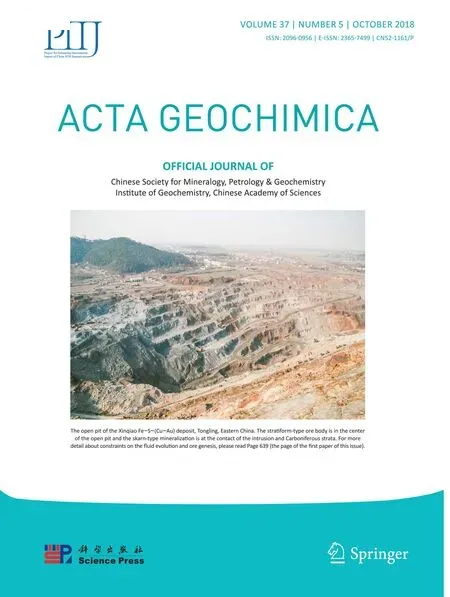Trace element composition of magnetite from the Xinqiao Fe-S(-Cu-Au)deposit,Tongling,Eastern China:constraints on fluid evolution and ore genesis
2018-10-26····
····
Abstract The Xinqiao deposit is one of several polymetallic deposits in the Tongling ore district.There are two types of mineralization in the Xinqiao:skarn-type and stratiform-type.The skarn-type mineralization is characterized by iron oxides such as magnetite and hematite,whereas stratiform-type mineralization is characterized by massive sulfides with small amounts of magnetite and hematite.We defined three types of ores within the stratiform-type mineralization by the mineral assemblages and ore structures.Type I ore is represented by magnetite crosscut by minor calcite veins.Type II is a network ore composed of magnetite and crosscutting pyrite.Type III is a massive ore containing calcite and hematite.Type I magnetite is characterized by highly variable trace element content,whereas Type II magnetite has consistently higher Si,Ti,V,and Nb.Type III magnetite contains more In,Sn,and As than the other two types.Fluid–rock interaction,oxygen fugacity(fO2),and temperature(T)are the main factors controlling element variation between the different magnetite types.Type I magnetite was formed by more extensive fluid–rock interaction than the other two types at moderate fO2and T conditions.Type II magnetite is thought to have formed in relatively low fO2and high-T environments,and Type III in relatively high fO2and moderate-T environments.Ca+Al+Mn and Ti+V discrimination diagrams show that magnetite in the Xinqiao deposit is hydrothermal in origin and is possibly linked with skarn.
Keywords Xinqiao⋅Skarn⋅Magnetite⋅In-situ analysis⋅Tongling
1 Introduction
The Tongling ore district,Anhui Province,Eastern China,is one of the most important parts of the middle-lower Yangtze River Metallogenic Belt(MLYMB)(Fig.1).This ore district contains a number of Fe-S(-Cu-Au)deposits,such as the Tongguanshan,Fenghuangshan,Dongguashan,and Xinqiao.Previous studies of these deposits have focused on the age and petrogenesis of granite(Ganguo et al.2004;Wang et al.2008;Mao et al.2011),and on the age(Xu 2004;Mao et al.2006;Wang et al.2015;Li et al.2016;Zhang et al.2018),and ore-forming fluids of mineralization at Xinqiao(Zeng et al.2004;Zengqian et al.2007;Xie et al.2009;Zhang et al.2017a;Chen et al.2016;Li et al.2018).In spite of numerous studies,the genesis of stratiform mineralization remains highly debated.Because of the occurrence of colloform pyrite,some researchers believe these deposits are of submarine exhalative sedimentary(SEDEX)origin(Gu and Xu 1986;Xiao and Ni 2000;Xu and Zhou 2001;Gu et al.2003;Li et al.2004;Xu et al.2004).Based on regional metallogenesis features and ore deposit geology(Fig.2),other studies have concluded that Fe–S mineralization is directly linked with magmatism(Chang and Liu 1983;Yang and Wang 1985;Chang et al.1991;Zhai et al.1992;Pan and Dong 1999;Mao et al.2009,2011).It is believed by some that later magmatic(hydrothermal) mineralization overprinted the early SEDEX mineralization(Yang et al.1982;Liu and Liu 1991;Xie and Wang 1995;Tang et al.1998;Zang et al.2004,2007;Zeng et al.2004;Lu 2008;Zhou et al.2010;Guo et al.2011;Li et al.2016;Zhang et al.2017a,b,c).Why some of these stratiform ore bodies contain such massive disseminated magnetite ores is still unknown.
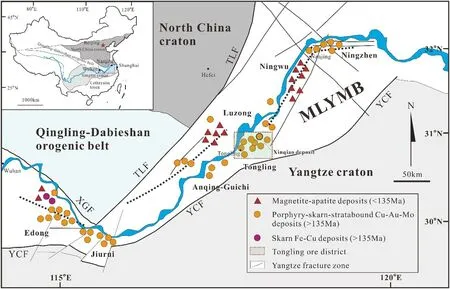
Fig.1 Geological map showing the location of Tongling ore area in the Middle-Lower Yangtze River metallogenic belt(MLYMB).TLF Tancheng–Lujiang fault,XGF Xiangfan–Guangjifault,YCF Yangxing–Changzhou fault.Modified from Pan and Dong(1999),Mao et al.(2011)

Fig.2 Simplified map showing the geological features of the Xinqiao ore district.Modified from Xu and Zhou(2001)
Magnetite is a common accessory mineral in many ore deposits,and one of the most abundant oxide minerals in continental crust.It forms with a range of trace element compositions under a wide range of temperature(T),pressure,oxygen/sulfur fugacity(fO2/fS2),cooling rate,matrix/melt ratio,and fluid composition(Frost and Lindsley 1991;Dare et al.2014;Nadoll et al.2014).With the development of laser ablation–inductively coupled plasma–mass spectrometry(LA–ICP–MS),in-situ measurements can be obtained with low detection limits for most trace elements,promoting the use of magnetite as an indicator mineral in deciphering the origin and evolution of ore-forming systems(Nadoll and Koenig 2011;Dare et al.2014;Nadoll et al.2014).Many studies have demonstrated that the variability in trace elements of magnetite can provide critical information about the origin of deposits.Trace element composition of magnetite in a variety of deposit types such as Ni–Cu–platinum-group element(Dare et al.2012;Gao et al.2013;Boutroy et al.2014;Duran et al.2016),skarn(Nadoll et al.2015;Zhao and Zhou 2015;Huang et al.2016,2018;Wang et al.2017),porphyry(Nadoll et al.2015;Canil et al.2016;Pisiak et al.2017),magmatic Fe–Ti(Liu et al.2015),volcanic-hosted magmatic hydrothermal(Huang et al.2013,2014;Milani et al.2017),volcanogenic massive sulfide(VMS)(Makvandi et al.2016),iron oxide–copper–gold(IOCG)(Carew 2004;Acosta-Góngora et al.2014;Chen et al.2015a,b),iron oxide–apatite(IOA)(Knipping et al.2015a,b),and banded iron formation(BIF)(Angerer et al.2012;Chung et al.2015;Sun et al.2018)deposits have provided detailed information about source and ore-forming processes.In addition,the variation of trace elements in magnetite can be used as a petrogenetic indicator(Dare et al.2015)or to trace remobilization(Huang et al.2015a,b).
In this paper,we describe the ore petrography with emphasis on the different types of magnetite-rich ores from the Xinqiao deposit.Trace element compositions of magnetite from Fe–Cu ores were determined by LA–ICP–MS.The new dataset provides a better understanding of trace element behavior in magnetite during the hydrothermal process.The main controlling factors for the variations in magnetite between different types of ores are discussed below.Through comparison of the composition Xinqiao magnetite with that of other deposits worldwide,we conclude that magnetite in Xinqiao is of magmatic-hydrothermal origin.Implications for ore genesis are also discussed.
2 Geologic background
The MLYMB,in the northern margin of the Yangtze Block,is famous for its abundance of polymetallic deposits(more than 200)and is one of the most economically important metallogenic belts in China(Fig.1)(Pan and Dong 1999).The MLYMB is mainly controlled by the Yangtze fracture zone along the middle of the metallogenic belt(Chang et al.1991;Pan and Dong 1999).This fracture zone is thought to have initiated in the Neoproterozoic and reactivated in the Triassic and Cretaceous(Pan and Dong 1999;Mao et al.2011).Aside from the Yangtze fracture zone,the most notable faults and folds are related to the Indosinian event(220–230 Ma),with most magmatism and mineralization occurring during the Yanshanian event(120–145 Ma).The MLYMB is composed of seven important mineral districts:the Edong,Jiurui,Anqing-Guichi, Tongling,Luzong,Ningwu,and Ningzhen(Fig.1),which are clustered from southwest to northeast.The Tongling ore district is in the middle of the MLYMB(Pan and Dong 1999;Xu and Zhou 2001;Mao et al.2011).
Tectonically,the Xinqiao Fe–S–(Cu–Au)deposit is located at the intersection of the Indosinian NE-oriented Dachengshan anticline,the Indosinian NE-oriented Shujiadian anticline,and the Yanshanian NNE-oriented Shengchong syncline(Fig.2).With the NNE-and NE-oriented normal faults overprinted,the Shengchong syncline is a major ore-controlling structure in this deposit and influenced the emplacement of the Jitou stock(Xu and Zhou 2001).The Jitou stock,composed of central quartz diorite and peripheral quartz dioritic porphyry,is the main igneous rock exposed in the Xinqiao deposit area(Fig.3),with a SHRIMP zircon U–Pb age of 140.4± 2.2 Ma(Y Wang et al.2004).Skarn alteration and sulfide mineralization are closely associated with this intrusion(Xu and Zhou 2001).The strata cropping out in this area range from middle-upper Silurian to Lower Triassic,but the Lower-Middle Devonian is absent(Fig.3).The Upper Devonian Wutong formation is composed of quartz sandstone and siltstone,and usually occurs as the footwall of the stratiform ore body.The middle-upper Carboniferous Huanglong and Chuanshan formations are mainly composed of dolomite and limestone,acting as the main ore-hosting strata of the stratiform ore body.The lower Permian Qixia formation consists of thick-bedded and stylolitic limestones,carbonaceous shale,and sandy shale.The Chuanshan or Qixia limestone usually occurs as the hanging wall of the stratiform ore body.
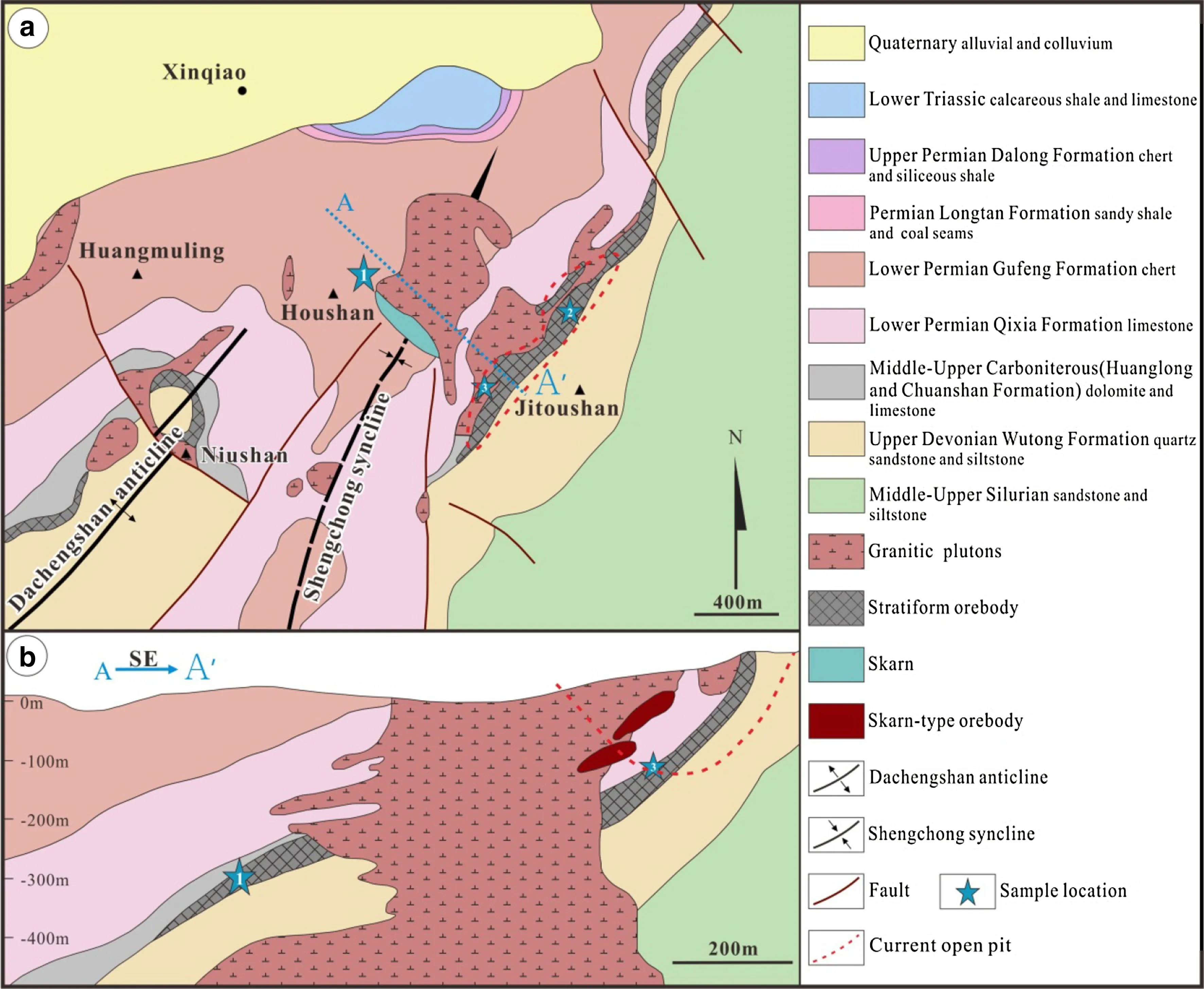
Fig.3 Geological map of Xinqiao Fe–S–(Cu–Au)deposit in Tongling of Anhui Province[modified from Tang et al.(1998),Zang et al.(2004),Zhang et al.(2017b)]
The Xinqiao deposit is one of the largest deposits in the Tongling ore district,containing an estimated 0.5 Mt Cu with a grade of 0.71%,75.5 Mt sulfur with a grade of 29.3%,24.9 Mt Fe with a grade of 46%,11.2 t Au with a grade of 4.7 g/t,and 248.4 t Ag with a grade of 248.4 g/t(Xu and Zhou 2001).There are two different types of mineralization in the deposit:skarn-type and stratiformtype.The skarn type is restricted to the contact between the Jitou stock and Carboniferous Qixia,Huanglong,or Chuanshan formation limestones(Fig.3a).The skarn ore body constitutes 10%of the deposit reserve(Zang et al.2004).Ore minerals in skarn are mainly magnetite,with minor pyrite,chalcopyrite,galena,and sphalerite;gangue minerals include garnet,diopside,actinolite,quartz,and calcite.The stratiform-type mineralization is hosted in the lower Carboniferous Gaolishan siltstone and overlying middle Carboniferous Huanglong limestone(Fig.3a).The stratiform ore body,which strikes NE and dips to the northwest,is 2550 m long and 1810 m wide,averaging 25 m in thickness.The stratiform mineralization is dominated by pyrite,with minor amounts of chalcopyrite,magnetite,pyrrhotite, galena,sphalerite,quartz,and dolomite.Stratiform ores are primarily massive and consist of more than 90%pyrite(Xu and Zhou 2001).Colloform pyrite ore,in the lower part of the stratiform ore body,is parallel to the bedding of siltstone and limestone.Lensshaped massive and disseminated magnetite ores occurred at the contact of the Jitou stock and the stratiform ore,with a length of 450 m,a width of 300 m,and average thickness of 10 m.Pyrites between the colloform pyrite ores and magnetite ores are generally recrystallized.
3 Ore petrography
Samples in this study were collected from three different positions of the stratiform-type mineralization of the Xinqiao deposit(Fig.3a).According to the mineral assemblages,these samples were divided into three types,which corresponded to three different locations in the Xinqiao deposit(Fig.3).Type I samples were farthest away from the Jitou stock,whereas type II samples were nearest to the skarn-type ore body.Type III samples were nearest to wall rocks.
In the first location(Fig.3b,point 1),eleven samples(XQ02,XQ0702,XQ09,XQ12,XQ2201,XQ2202,XQ23,XQ24,XQ25,XQ27,and XQ2801)were collected from-300 m in a mining adit.These samples were classified as type I ore and accordingly,magnetite in these samples was called type I magnetite.Ores were composed of~75 vol%magnetite,~15 vol%calcite+quartz,and~10 vol% pyrite,with minorchalcopyriteand hematite(Figs.4a,b,5a–d).Magnetite mainly showed anhedral or subhedral granular texture(Fig.5a),with grain size ranging from 10 to 200 μm in diameter.Locally,interstices of magnetite grains were filled by pyrite(Fig.5b).Both magnetite and pyrite were crosscut by calcite veinlets(Fig.5b),indicating interstitial pyrite formed later than magnetite but earlier than calcite.
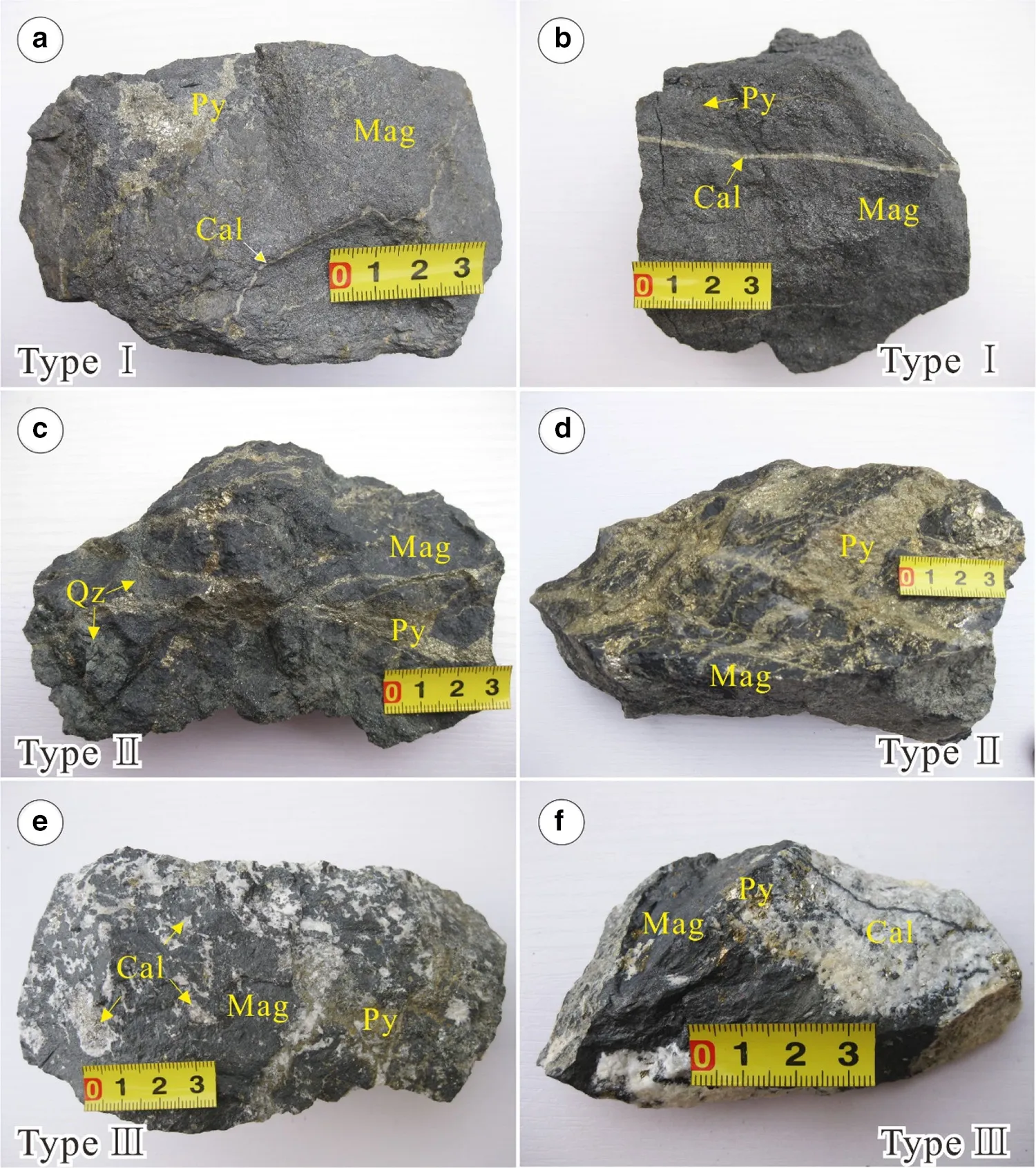
Fig.4 Photographs of three types of ores from the Xinqiao deposit.a,b Type Imassive ore composed of mainly magnetite and minor pyrite and calcite.Pyrite is disseminated in ore and locally occurs as massive aggregates.Calcite veins commonly crosscut the massive ore.c,d Type II network ore composed of magnetite,pyrite and minor quartz.Pyrite occurs as veins or veinlets crosscutting the ore.e,f Type III massive ore consisting of magnetite,calcite,and pyrite.Mineral abbreviations:Mag magnetite,Py pyrite,Cal calcite Qz quartz.The yellow rule in images is cm in scale
In the other two places(Fig.3a,points 2 and 3), five samples were collected at–120 m in a mining adit.Two samples(XQ32 and XQ36)from point 2,which belonged to type II,were composed of~ 65 vol%magnetite,~ 25 vol% pyrite+chalcopyrite,and~10vol% calcite+quartz(Figs.4c,d,5e,f).These ores commonly showed network structure,crosscut by pyrite veinlets(Fig.4c,d).Massive magnetite was partly replaced by hematite at the grain margin(Fig.5e,f).
Three samples(XQ4005,XQ4101,and XQ4102)were collected from point 3,near carbonates(Fig.3a).These samples were defined as type III ore and were composed of~ 60 vol%magnetite,~ 20 vol%calcite+quartz,~ 10 vol%hematite,and~10 vol%pyrite+chalcopyrite(Figs.4e,f,5h,i).Magnetite was observed to be locally replaced by pyrite and chalcopyrite(Fig.5h,i).
4 Analytical methods
Samples were observed by optical microscopy and scanning electron microscopy(SEM)to characterize mineral association and texture prior to LA–ICP–MS analyses.Due to gangue mineral inclusions in magnetite and magnetite grains replaced by hematite,magnetite was chosen carefully for LA analysis to avoid signal contamination from other minerals and from later alteration.All analyses were performed at the State Key Laboratory of Ore Deposit Geochemistry,Institute of Geochemistry,Chinese Academy of Sciences.

Fig.5 Photomicrographs of three types of ores from the Xinqiao deposit.a Subhedral magnetite(Type I)associated with calcite,b subhedral magnetite(Type I)replaced by pyrite and associated with calcite,c massive magnetite aggregates(Type I)associated with pyrite and minor chalcopyrite that were crosscut by calcite veins,d subhedral to need-like magnetite(Type I)associated with quartz and pyrite,e anhedral magnetite(Type II)replaced by hematite forming porous variety,f anhedral magnetite(Type II)associated with pyrite and quartz.Part of magnetite was replaced by hematite,g massive magnetite aggregates(Type III)showing some fractures.h Need-like magnetite(Type III)associated with pyrite and quartz,which was partly replaced by hematite,i fine-grained magnetite associated with hematite,pyrite,and chalcopyrite.Mineral abbreviations:Mag magnetite,Py pyrite,Cal calcite Qz quartz Ccp chalcopyrite,Hem hematite
Major and trace elements of magnetite were analyzed using a Coherent GeoLasPro 193 nm laser ablation system coupled with an Agilent 7700x ICP–MS.The method has been described in detail in Gao et al.(2013),Huang et al.(2013),and Meng et al.(2016).Each analysis cycle is composed of a~20 s period of background acquisition followed by 40 s of useful data acquisition from the sample.Approximately 44 μm of analytical spots were ablated by 160 successive laser pulses(4 Hz).Selected magnetite grains were larger than the ablation spot size.USGS synthetic glass GSE-1G and USGS basalt glasses BCR-2G,BIR-1G,and BHVO-2G were used as reference materials for element content calibration,using57Fe as the internal standard(Gao et al.2013).GSE-1G was also used as the quality control to correct time-dependent signal drift and mass discrimination.The sum concentrations of all elements,expressed as oxides according to their oxidation states in magnetite,are considered to be 100 wt%for a given anhydrous mineral(Liu et al.2008).Data reduction was performed by ICPMS Data Cal(Liu et al.2008).
5 Analytical results
Detailed LA–ICP–MS results of the three types of magnetite are shown in Appendix 1(supplementary material).The minimum,maximum,and average values of trace element contents are summarized in Table 1 and Fig.6.Twenty-two elements were detected,including lithophile elements(Na,Mg,Al,Si,Ca,Sc,Ti,V,Mn,Ga,Ge,Sr,Y,Nb,and W)and chalcophile elements(Co,Zn,As,In,Sn,Sb,and Bi).

Table 1 Minimum,maximum,and average concentrations(in ppm)of the selected elements in different magnetite types from the Xinqiao deposit

Fig.6 Multiple element diagram showing the minimum,maximum,and average elemental concentration in magnetite from the Xinqiao deposit
Magnetite from the Xinqiao deposit contained variable Mg,Al,Si,Ca,and Mn(Table 1;Fig.6).Silicon,Ti,V,and Nb contents were typically higher in type II than the other two types,but Mg,Mn,In,and Sn were typically lower(Table 1;Fig.6).Scandium and Ga did not show significant variation among the three types(Table 1;Fig.6).

Fig.7 Binary plots showing the correlation of elements in magnetite.a Ti versus V,b Co versus Zn,c In versus Sn,d Zn versus Mn,e Sb versus W,f Al versus Sc,g Al versus Mn,h Mg versus Mn
Some elements in magnetite showed good correlation.There was a positive correlation between V and Ti(Fig.7a).Zinc showed a positive correlation with Co and Mn(Fig.7b–d).Indium showed a positive correlation with Sn(Fig.7c).There was a positive correlation between Sb and W(Fig.7e).Aluminum showed a negative correlation with Sc(Fig.7f).Manganese was positively correlated with Al and Mg(Fig.7g,h).
Figure 8 shows the compositional differences between the three types of magnetite.In type I,there was a wide range of element content(Fig.8).Higher Al,V,and Ti,and lower Sn,In,and As were observed in type II(Fig.8);and higher Sn,In,and As,and lower V and Ti were observed in type III(Fig.8).
6 Discussion
6.1 Element behavior in hydrothermal magnetite
The co-variation of elements in magnetite is always related to its origin.For example,Ti,V,Cr,Co,Ni,and Zn<

Fig.8 Binary plot of trace elements in magnetite showing compositional differences between three different magnetite types
10 ppm and Co/Ni ratios>0.1 characterize magnetite of BIF(Bajwah et al.1987;Figueiredo et al.2009;Nadoll et al.2014).Vanadium and Cr decrease with increasing Ti during silicate fractionation(Dare et al.2014),whereas V and Ti decrease without systematic Cr variation during hydrothermal evolution(Huang et al.2013).Nickel and Cr are coupled in silicate magmas with Ni/Cr ratios<1 because they behave compatibly during fractionation of intermediate and felsic melts,whereas they are decoupled in many hydrothermal settings with higher Ni/Cr ratios,most likely due to a higher solubility of Ni compared to Cr in fluids(Dare et al.2014).
The positive correlation between V and Ti of magnetite in Xinqiao(Fig.7a)is consistent with the elements’compatible behavior in hydrothermal magnetite(Huang et al.2013,2014;Zhao and Zhou 2015).The positive correlation between Co and Zn(Fig.7b)also indicates chalcophile behavior similar to that in hydrothermal fluids.The positive correlation of In and Sn(Fig.7c)further implies chalcophile behavior similar to that in granite-related hydrothermal fluids(cf.Nadoll et al.2014).The positive correlation of Mn and Zn(Fig.7d)in magnetite is likely related to chlorine-rich fluids,particularly those related to skarn deposits(Ilton and Eugster 1989).The positive relationship between W and Sb(Fig.7e)in magnetite suggests involvement of granite-related fluids because elevated W,Pb,As,Mo,and Sn concentrations are attributed to hydrothermal metasomatism related to granitic magmatism(Nadoll et al.2014).The negative correlation between Sc and Al(Fig.7f)implies their contrasting behavior in hydrothermal fluids,possibly due to the incompatibility of Al in magnetite,moderate compatibility of Sc(DAl=0.17,DSc=1.6)(Dare et al.2012),and low solubility of both elements in hydrothermal fluids(Pearce and Cann 1973;Floyd and Winchester 1978;Middelburg et al.1988).
6.2 Possible factors controlling the compositional variation of magnetite
The trace element contents of hydrothermal magnetite are controlled by various factors under different hydrothermal environments,as has been reviewed by Nadoll et al.(2014).The concentration of an element in hydrothermal magnetite may depend on(a)element concentration in the fluid from which magnetite crystallized,(b)degrees and processes of fluid–rock interaction,(c)competition of cocrystallizing minerals,and(d)physicochemical conditions such as T,pressure,fO2,and fS2which affect the partition coefficient of the element in magnetite(e.g.,Dare et al.2014;Nadoll et al.2014;Huang et al.2016).
Magnetite could have formed during fluid–rock interaction(Table 2).Trace elements show different behavior during this process(Nadoll et al.2014).In some instances,Mg and Mn tend to go into hydrothermal fluids through extensive fluid–rock interactions in skarn deposits(Einaudi 1981;Meinert 1992).Magmatic fluids are enriched in Si,Al,Na,K,Fe,F,and Cl(Tosdal et al.2009)and carbonate rocks tend to be enriched in Ca,Mg,and Mn.Based on the behavior of these elements(Huang et al.2014,2016)plotted a discrimination diagram of Mg+Mn and Si+Al element assemblages to evaluate the degree of fluid–rockinteraction in skarn processes.The three types of magnetite from the Xinqiao deposit were all found to contain detectable Mg,Mn,Al,and Si(Table 1),enabling the use of Mg+Mn and Si+Al element assemblages in studying fluid–rock interaction.The well-defined positive correlations of Mn with Al and Mg(Fig.7 g,h)reflect their similar behavior during the hydrothermal process.Type I magnetite had a wider range of Mn,Mg,and Al(Fig.7g,h),suggesting that the type I ores have experienced extensive fluid–rock interaction.
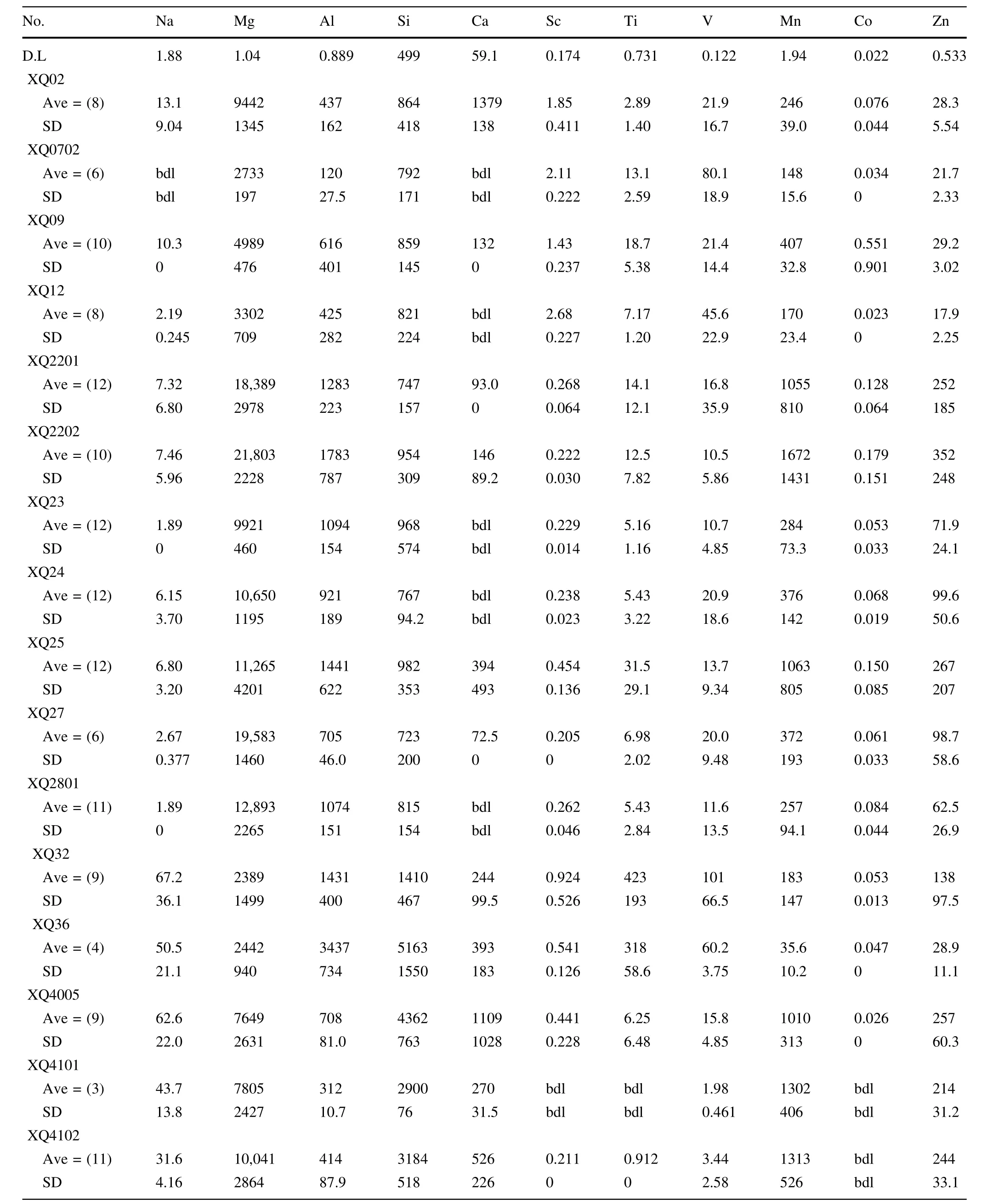
Table 2 LA–ICP–MS results for trace elements(ppm)in magnetite from the Xinqiao Fe–S–(Cu–Au)deposit,Eastern China
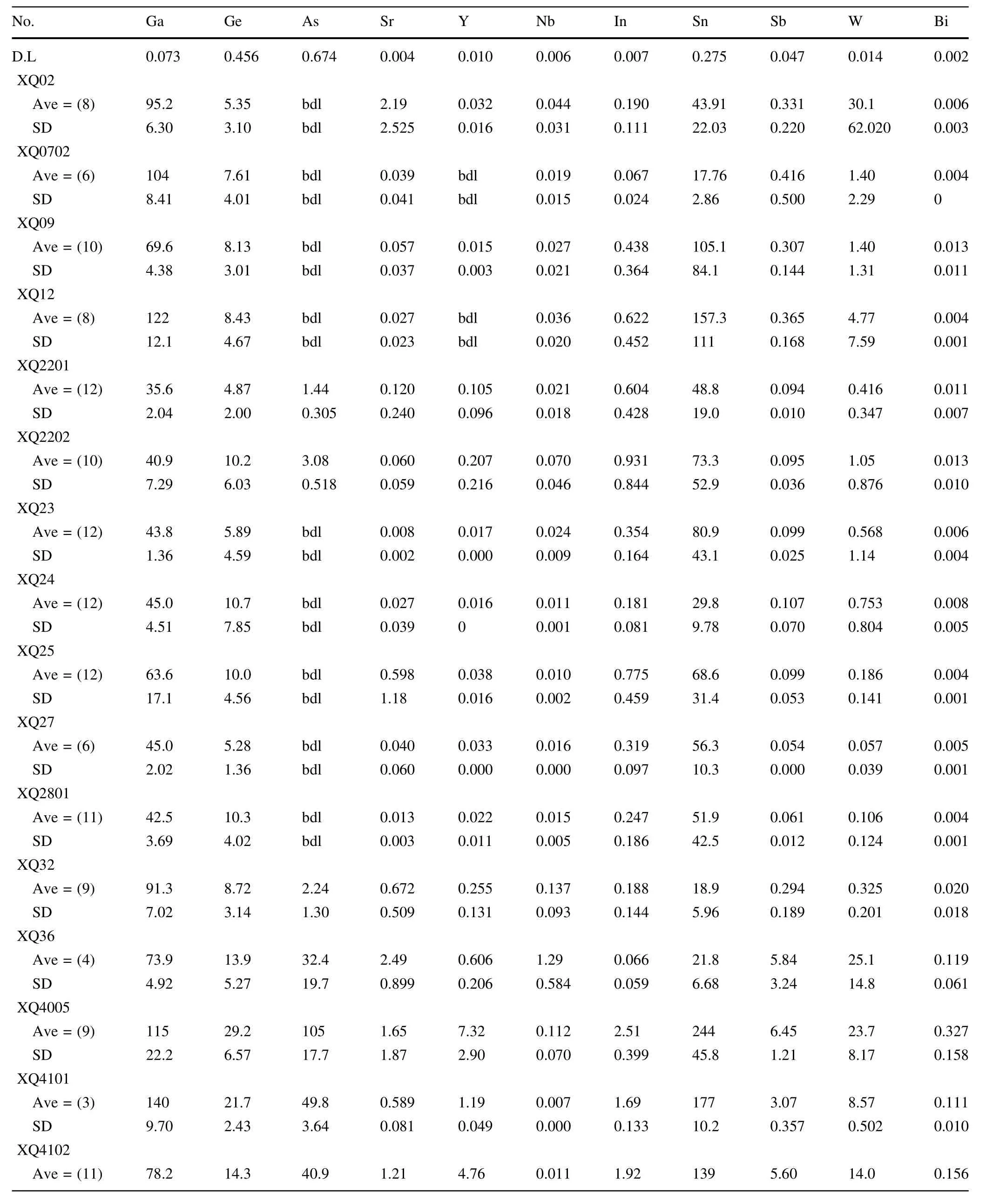
Table 2 continued

Table 2 continued
Aside from the concentration of elements in fluids,the variation of fO2could potentially impact the concentration of trace elements in hydrothermal magnetite(Nadoll et al.2014,2015;Chen et al.2015a).Tin and V have several valence states in hydrothermal fluids with variable fO2values.Increasing fO2can increase the incorporation of Sn into magnetite(Carew 2004).On the contrary,V3+has a higher partition,making it more compatible with magnetite with decreasing fO2(Toplis and Corgne 2002).In the Xinqiao deposit,the three types of magnetite formed under distinct fO2environments,as reflected by the binary plots(Fig.8).There was a rough negative correlation between Sn and V(Fig.8a)among the three types of magnetite in the Xinqiao deposit,consistent with their varied fO2.Type III magnetite had higher Sn and lower V content(Fig.8a),indicating formation at a relatively high fO2.In contrast,type II magnetite had lower Sn and higher V content(Fig.8a),indicating a lower fO2condition.Type I magnetite had intermediate Sn and V contents,indicating formation at fO2between that of types II and III.
Because T can impact partition coefficients(McIntire 1963),it is regarded as a major factor for the trace element composition of hydrothermal magnetite. High-T hydrothermal porphyry and skarn magnetite present relatively high trace element concentrations;primary magnetite from BIF has the lowest trace element concentration(Nadoll et al.2014).Hydrothermal magnetite from high-T deposits(IOCG and porphyry Cu)has a different elemental composition than that from low-T environments(BIF and Fe skarn)(Dare et al.2014).The former contains higher Sn,Ga,Mn,Ti,Zn,Co,and V and lower Si than the latter(Fig.9).The Xinqiao magnetite had an elemental composition similar to high-T hydrothermal magnetite except for low Ti and Co(Fig.9).Although Nadoll et al.(2014)have shown that Ti is a good T indicator,granite-related hydrothermal fluids are likely depleted in Ti,so magnetite crystallized from these particular fluids would have low Ti.There was a positive correlation between V and Ti in the three types of magnetite(Fig.7a).A similar correlation of these elements has also been documented in magnetite from the Tengtie skarn deposit in the Nanling Range(Zhao and Zhou 2015),but there is no correlation of these elements in magnetite from the Fenghuangshan skarn deposit in the Tongling area,which is near the Xinqiao skarn deposit(Fig.9).From type II magnetite to types I and III,V and Ti contents decreased,implying decreasing T and increasing fO2.
6.3 Discrimination diagrams for magnetite
Trace element composition of magnetite has been used to determine its origin(Dupuis and Beaudoin 2011;Dare et al.2014;Nadoll et al.2014).Dupuis and Beaudoin(2011)proposed Ni/(Cr+Mn)versus Ti+V and Ca+Al+Mn versus Ti+V diagrams to distinguish magnetite from IOCG,Kiruna,porphyry Cu,BIF,skarn,and Fe-Ti-V deposits.These diagrams have been widely used and evaluated in recent studies(Acosta-Góngora et al.2014;Chen et al.2015a,b;Chung et al.2015;Huang et al.2015a,b,2016;Liu et al.2015;Nadoll et al.2015;Zhao and Zhou 2015;Canil et al.2016;Sun et al.2018).Dare et al.(2015)proposed multi-element variation diagrams to distinguish between magnetite from magmatic,high-T hydrothermal,and low-T hydrothermal environments.Compared with high-T hydrothermal magnetite,magnetite from the Xinqiao deposit had lower Sc,Nb,Ti,Co,and V(Fig.9).Compared with low-T hydrothermal magnetite,magnetite from the Xinqiao deposit had higher Sn,Ga,Mn,and Mg,but lower Ti and Co contents(Fig.9).Lower Ti and V in Xinqiao magnetite than in high-T hydrothermal magnetite(e.g.,porphyry,IOCG)indicates low formation T and higher fO2.Xinqiao magnetite had higher Mn and Mg contents than low-T hydrothermal magnetite(e.g.,Ag–Pb–Zn veins),consistent with intensive fluid–rock interaction as these elements are sensitive to host-rock buffering(Nadoll et al.2014;Huang et al.2016).

Fig.9 Normalized multi-element variation diagrams of magnetite from the Xinqiao deposit,compared with hydrothermal magnetite from high temperature(T)deposits[IOCG and porphyry-Cu(yellow field)]and hydrothermal magnetite from low-temperature(T)environments[BIF and Fe skarn(blue fields)].Data of Sn,Ti and V are from Zhao and Zhou(2015)and Huang et al.(2016).All data fields are modified after Dare et al.(2014).Normalization values of bulk continental crust are from Rudnick and Gao(2003).Elements are ordered with increasing compatibility with magnetite to the right.DL the detection limit for a 44 μm beam size

Fig.10 Plots of Ca+Al+Mn versus Ti+V for LA–ICP–MS data of magnetite from the Xinqiao deposit.Reference fields are adapted from Dupuis and Beaudoin(2011).BIF banded iron formation,Skarn Fe–Cu skarn deposits,Kiruna,Kiruna apatitemagnetite deposits,Fe–Ti,V magmatic Fe–Ti-oxide deposits.Data used in this plot are individual analyses
Nadoll et al.(2015)suggested when the Ca concentrations of magnetite are lower than detection limits or when Ca concentrations are orders of magnitude lower than Al and Mn concentrations,Ca can be removed from the element assemblage of Ca+Al+Mn for the discrimination diagram,but Huang et al.(2016)suggested that Ca and Mg should be chosen by discrimination factors for magnetite,because their concentrations could be increased in hydrothermal fluids due to extensive fluid–rock interaction,particularly in skarn-related deposits.For the Xinqiao deposit,calcium content of magnetite was lower than the detection limit(~60 ppm)for most of the type I samples.Comparing the two different element assemblage discrimination factors(Ca+Al+Mn vs Al+Mn),we found that Ca contributes only negligibly to the total contents of Ca+Al+Mn(Fig.10).Different types of magnetite from the Xinqiao deposit plotted in the skarn field in the Ca+Al+Mn versusTi+V diagram(Fig.10),indicating that they are hydrothermal in origin,with skarn affinity.This is consistent with the results of multiple-element spider diagram(Fig.9).The three types of magnetite samples were divided into two groups with different Ti+V contents(Fig.10);these differences may be due to different formation temperatures.Among the three types,type II magnetite had the highest temperature,possibly due proximity to the igneous body.
6.4 Implications for ore genesis
The genesis of these stratiform ore bodies has been argued for decades.Some authors have considered the source to be associated with late Paleozoic(Hercynian)submarine exhalation(Xu and Zhou 2001;Xu et al.2004).Several studies advocate that their origin is related to Early Cretaceous (Yanshanian) magmatic-hydrothermal fluids(Chang and Liu 1983;Chang et al.1991;Pan and Dong 1999;Mao et al.2011;Zhang et al.2017a,b,c).Other studies have suggested the bodies are connected with Cretaceous magnetism overprinting Carboniferous submarine exhalation mineralization(Xie and Wang 1995;Zhou et al.2010;Guo et al.2011).In our study,the composition of trace elements in magnetite showed a skarn hydrothermal origin feature(Fig.10),implying that the magnetite in stratiform ore bodies could be hydrothermal in origin.Thus,the two types of magnetite mineralization in the Xinqiao deposit,skarn-type and stratiform-type,may share the same source.It is noted that compositions and formation physicochemical conditions(T and fO2)of magnetite,show a rough correlation with distance to igneous rock,implying that hydrothermal fluids and their reaction with carbonate rocks have played an important role in the formation of magnetite in stratiform ores.
7 Conclusions
Three types of ores were identified in stratiform-type mineralization according to mineral assemblages and ore structures.Type I ore is represented by high-purity magnetite crosscut by minor calcite veins.Type II is network ore composed of magnetite and crosscutting pyrite.Type III is massive ore containing calcite and hematite.Positive correlations among Mg,Al,and Mn and between V and Ti,indicate that these elements behave similarly during the hydrothermal process.The positive correlations among chalcophile elements Co,Zn,In,and Sn also indicate their similar behavior in hydrothermal fluids.Type I magnetite was characterized by a wide range content of trace elements,whereas Type II magnetite had higher Si,Ti,V,and Nb.Type III magnetite contained more In,Sn,and As.Fluid–rock interaction,fO2,and T were the main factors controlling element variation between different magnetite types.Type II magnetite may have formed in relatively low fO2and high-T environments,whereas Type III magnetite may have formed in relatively high fO2and moderate-T environments.Type I magnetite formed by more extensive fluid–rock interaction than the other two types and at a wide range of fO2and T conditions.The Ca+Al+Mn and Ti+V discrimination diagram shows that magnetite in the Xinqiao deposit is likely hydrothermal in origin with skarn affinity.
AcknowledgementsThis study was supported by grants from the National Key R&D Program of China(2016YFC0600207),the Chinese 973 project(2012CB416804),the National Natural Science Foundation of China(41503039),and the ‘‘CAS Hundred Talents’’Project to J.F.Gao(Y5CJ038000).Zhihui Dai and Shaohua Dong are thanked for their LA–ICP–MS and SEM analyses.We also appreciate the field assistance of geologists from the Xinqiao deposit,especially Yixia Wang and Bobo Guo.
杂志排行
Acta Geochimica的其它文章
- Lithium elemental and isotopic disequilibrium in minerals from peridotite xenoliths from Shangzhi,NE China:products of recent melt/ fluid-peridotite interaction
- The influence of climate and topography on chemical weathering of granitic regoliths in the monsoon region of China
- Dynamics of soil organic carbon following land-use change:insights from stable C-isotope analysis in black soil of Northeast China
- The performance of the Noblesse multi-collector noble gas mass spectrometer for40Ar/39Ar geochronology
- Geochemistry of the Palaeo-Mesoproterozoic Tadpatri shales,Cuddapah basin,India:implications on provenance,paleoweathering and paleoredox conditions
- Effects of a proline solution cover on the geochemical and mineralogical characteristics of high-sulfur coal gangue
